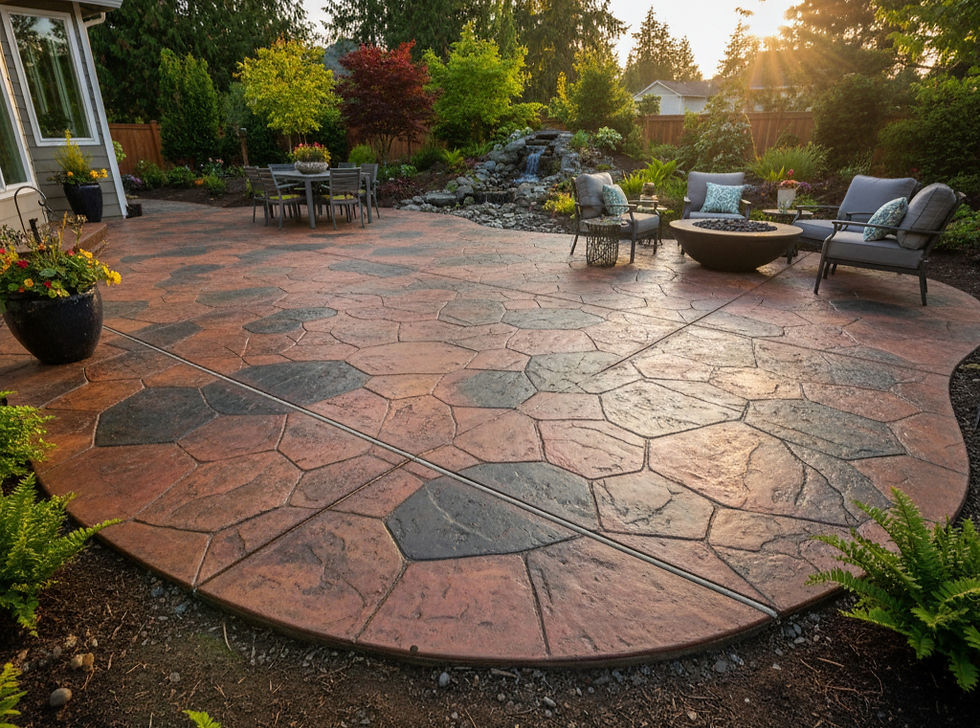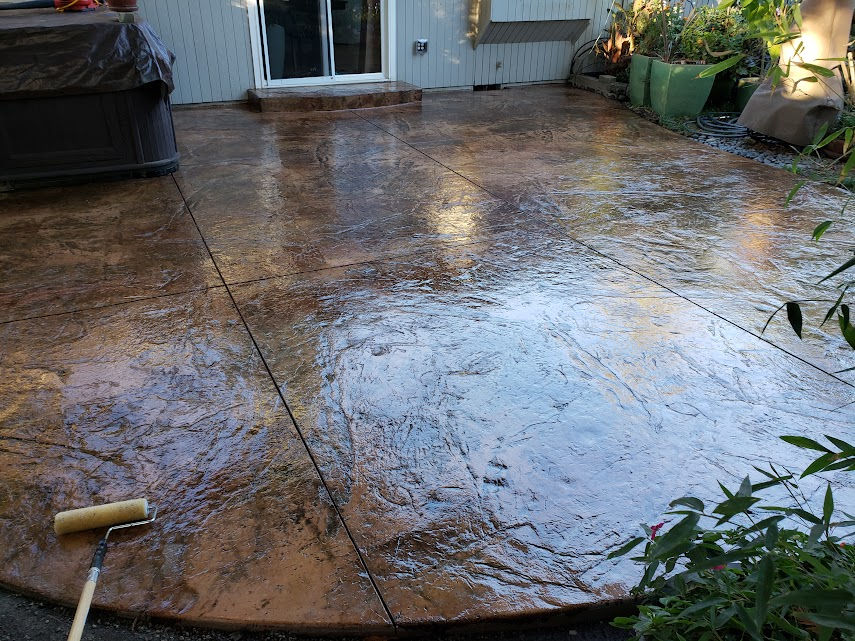Your Guide to Concrete Staining & Dyeing in Vancouver, WA
- Toki Concrete
- Aug 26
- 4 min read
Concrete doesn't have to be a drab, gray surface. At Toki Concrete of Vancouver, WA, we specialize in transforming ordinary concrete into stunning, vibrant, and durable features for your home or business. One of the most popular and effective ways to achieve this is through concrete staining and dyeing. Let's explore how these techniques can elevate your concrete, enhance its longevity, and provide a unique aesthetic that truly stands out.
What are Concrete Stains and Dyes?
Concrete stains and dyes are specialized coloring agents designed to penetrate the concrete surface, creating rich, translucent, and permanent colors that won't chip, flake, or peel like topical paints.
Aesthetics: They offer an incredible range of aesthetic possibilities, from earthy, mottled tones that mimic natural stone to vibrant, uniform hues. The translucent nature of stains allows the natural variations and characteristics of the concrete to show through, creating a unique and sophisticated finish.
Utility & Durability: Unlike paints that simply coat the surface, stains and dyes become an integral part of the concrete. This deep penetration means they are incredibly durable, resisting fading, abrasion, and moisture, making them ideal for high-traffic areas, both indoors and out.
Cost vs. Other Options: When considering coloring options, stains and dyes offer a fantastic balance of cost-effectiveness and durability.
Surface Paints and Sealers: While initially cheaper, paints and pigmented sealers sit on the surface and are prone to chipping, scratching, and fading over time, requiring more frequent reapplication and maintenance.
Integral Colors: Adding color directly into the concrete mix (integral color) is another option, but it can be more expensive and offers less artistic flexibility once poured.
No Coloring: While the most economical upfront, uncolored concrete lacks the aesthetic appeal and enhanced protective qualities that stains and dyes provide.
Staining & Dyeing: Before or After Curing? Are They the Same?
While often used interchangeably, concrete stains and dyes have distinct characteristics and application times:
Concrete Stains:
Types: Primarily acid-based stains (react with the lime in concrete) and water-based stains (pigmented and penetrate the surface).
Aesthetics: Acid stains create a mottled, variegated, and translucent look, similar to natural stone, due to their chemical reaction. Water-based stains offer a wider color palette and more consistent, yet still translucent, coverage.
Application: Stains are typically applied after the concrete has fully cured (usually 28 days) to ensure the chemical reaction can occur properly and the concrete is stable.
Concrete Dyes:
Type: Made from very fine pigment particles dissolved in a water or solvent-based carrier.
Aesthetics: Dyes provide a more uniform and opaque color than acid stains, yet still penetrate the surface for a durable finish. They offer an expansive range of vibrant colors.
Application: Dyes can be applied after the concrete is fully cured. They are often used to achieve more intense or specific colors.
So, while both are used for coloring concrete, they achieve different aesthetic results and rely on different chemical processes. Both are generally applied after the concrete has cured for best results and longevity.
Complementing Stamped Decorative Concrete Installations
One of the most exciting applications of concrete stains and dyes is their ability to enhance and complement stamped decorative concrete.

When concrete is stamped, it's impressed with patterns that mimic natural materials like stone, brick, or wood. Stains and dyes take this realism to the next level:
Adding Depth and Dimension: By using multiple colors or varying concentrations of stain, we can highlight the textures and contours of the stamped pattern, creating incredible depth and a more authentic appearance.
Mimicking Natural Hues: Stains and dyes allow us to replicate the subtle color variations found in natural flagstone, slate, or wood, making your stamped concrete virtually indistinguishable from the real thing.
Customization: The combination of stamping and coloring offers unparalleled customization, allowing you to achieve a truly bespoke look that perfectly matches your home's style.
Other Post-Cure Coloring Options & "Off the Beaten Path" Techniques
Once your concrete is cured, staining and dyeing are fantastic options, but there are a few other methods to consider for color changes or unique effects:
Topical Color Sealers: These are sealers with added pigment that coat the surface. While they offer opaque color and some protection, they sit on top of the concrete and can wear away over time, especially in high-traffic areas.
Epoxy Coatings: For garage floors or industrial settings, epoxy coatings offer extremely durable, high-gloss, and completely opaque color finishes. They are excellent for protection against chemicals, oil, and heavy abrasion.
Acid Washing: An acid wash is a cleaning process, not primarily a coloring one, that uses a mild acid solution to remove efflorescence, rust, mineral deposits, and brighten the concrete surface. While it can subtly lighten the concrete by removing surface contaminants, it doesn't impart color. It's often done before staining or sealing to prepare the surface.
Unlock Your Concrete's Potential with Toki Concrete!
Whether you're looking to revitalize an existing slab, enhance a new patio, or create a show-stopping interior floor, concrete staining and dyeing offer an artistic and durable solution. At Toki Concrete, we are passionate about bringing your vision to life. Our experts in Vancouver, WA, understand the nuances of these techniques and how to achieve the perfect look for your residential or commercial project.
Ready to transform your concrete from functional to fabulous? Contact Toki Concrete today for a consultation and let's explore the colorful possibilities!















Comments